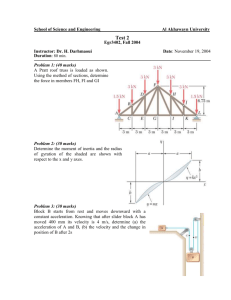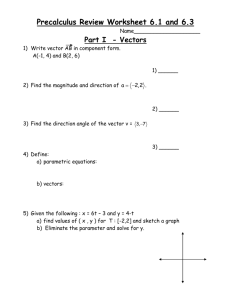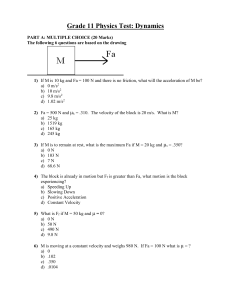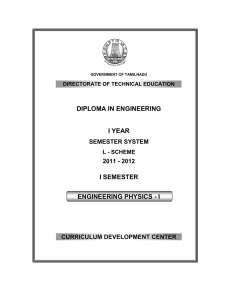Physics
advertisement
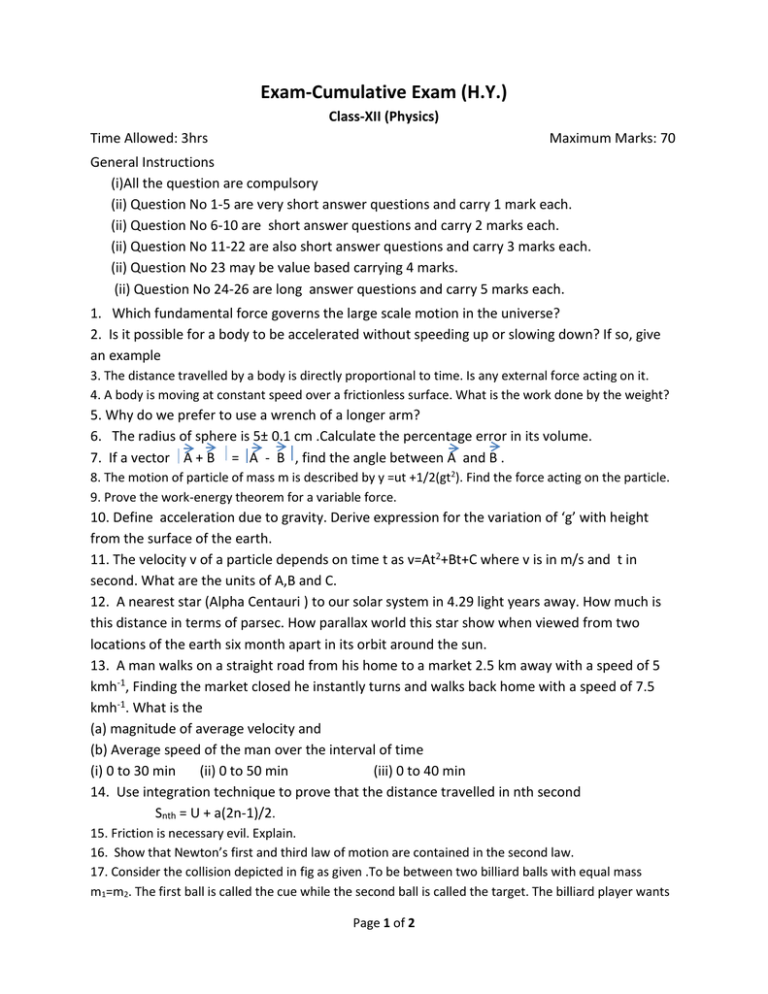
Exam-Cumulative Exam (H.Y.) Class-XII (Physics) Time Allowed: 3hrs Maximum Marks: 70 General Instructions (i)All the question are compulsory (ii) Question No 1-5 are very short answer questions and carry 1 mark each. (ii) Question No 6-10 are short answer questions and carry 2 marks each. (ii) Question No 11-22 are also short answer questions and carry 3 marks each. (ii) Question No 23 may be value based carrying 4 marks. (ii) Question No 24-26 are long answer questions and carry 5 marks each. 1. Which fundamental force governs the large scale motion in the universe? 2. Is it possible for a body to be accelerated without speeding up or slowing down? If so, give an example 3. The distance travelled by a body is directly proportional to time. Is any external force acting on it. 4. A body is moving at constant speed over a frictionless surface. What is the work done by the weight? 5. Why do we prefer to use a wrench of a longer arm? 6. The radius of sphere is 5± 0.1 cm .Calculate the percentage error in its volume. 7. If a vector A + B = A - B , find the angle between A and B . 8. The motion of particle of mass m is described by y =ut +1/2(gt2). Find the force acting on the particle. 9. Prove the work-energy theorem for a variable force. 10. Define acceleration due to gravity. Derive expression for the variation of ‘g’ with height from the surface of the earth. 11. The velocity v of a particle depends on time t as v=At2+Bt+C where v is in m/s and t in second. What are the units of A,B and C. 12. A nearest star (Alpha Centauri ) to our solar system in 4.29 light years away. How much is this distance in terms of parsec. How parallax world this star show when viewed from two locations of the earth six month apart in its orbit around the sun. 13. A man walks on a straight road from his home to a market 2.5 km away with a speed of 5 kmh-1, Finding the market closed he instantly turns and walks back home with a speed of 7.5 kmh-1. What is the (a) magnitude of average velocity and (b) Average speed of the man over the interval of time (i) 0 to 30 min (ii) 0 to 50 min (iii) 0 to 40 min 14. Use integration technique to prove that the distance travelled in nth second Snth = U + a(2n-1)/2. 15. Friction is necessary evil. Explain. 16. Show that Newton’s first and third law of motion are contained in the second law. 17. Consider the collision depicted in fig as given .To be between two billiard balls with equal mass m1=m2. The first ball is called the cue while the second ball is called the target. The billiard player wants Page 1 of 2 to “sink” the target ball in a corner pocket , which is at an angle θ2=370 . Assume that the collision is elastic and that friction and rotational motion ae not important. Obtain θ. 18. A well 20 m deep and 3m in diameter contains water to a depth of 14 metre. How long will a 5 hp engine take to empty. 19. Define radius of gyration of a body rotating about an axis. Derive an expression for it. On what factors does it depends? 20. define the theorem of parallel axis and perpendicular axis theorem. 21. Compare the weights of a body when it is (i) 100 km above the surface of the earth and (ii) 100 km below the surface of the earth. Radius of the earth is 6300 km. 22. Define the escape velocity. Derive an expression for escape velocity of an object from the surface of a planet. 23. Puneet decides to use his bath tub water to generate electric power to run a 40 W bulb. The bath tub is located at a height of 10m from the ground and it holds 200 liters of water. He installs a water driven wheel generator on the ground. Initially, he slowly drains water from the bath but bulb does not glow. He gradually increases the rate of water drainage and finally succeeds in making the bulb glow. (a) What are the values being displayed by Puneet. (b) What should be the bath tub for making the bulb glow? Can efficiency of generator = 90% and g=9.8 ms-2. 24 (a) Analytically find the resultant R of two vectors A and B inclined at an angle θ. (b) Find the angle between two vectors P and Q if the resultant of the vectors is given by R2 =P2 +Q2 OR (a) What is projectile motion? (b) The maximum range of projectile is 2/√3 time’s actual range. What is the angle of projection for the actual range? (c) Two balls are thrown with the same initial velocity at an angles α and (900 –α) with the horizontal. What will be the ratio of the maximum heights attained by them 25. Define angle of friction and angle of repose. Show that both are numerically equal. OR Derive an expression for velocity of a car on a banked circular road having coefficient of friction µ . hence write the expression for optimum velocity. 26.(a) Define orbital velocity and establish an expression for it. (b) Calculate the value of orbital velocity for an artificial satellite of earth orbiting at a height of 1000 km. Given Me = 6×1024 kg, Re = 6400 km. OR What is a geostationary satellite? What are the necessary conditions for a satellite to be geostationary and give some use of geostationary satellites? Page 2 of 2

